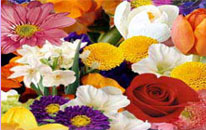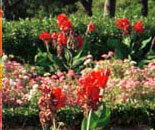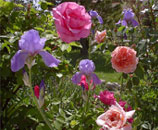|
Maharashtra is a major producer of floriculture products with more than 4000 Hectares. of area under various flowers. The major traditional flowers grown in Maharashtra are rose, chrysanthemum, marigold, jasmine and tuberose whereas, gladioluses, aster, zinnia, Stacie, lilies, gerberas and carnations are grown among the non traditional flowers.
The most important features of floriculture development in the State is setting up of large number of Export Oriented Unit with foreign collaboration and investment. The climate of Pune, Nashik region, facilitate the setting up of such unit without heavy investment on environment control. Oriental Floratech and Firoze Masani were the first units to be set up in India. Already various units e.g. Deccan Florabase, Valplus Biotech, Babna Major, Neha International, Vikram Greentech, Centure International, Essar Agrotech, Indrayani Biotech have commenced the production and export of flowers mainly roses to European and other markets from Maharashtra.
The utilisation of the process to improve the cold chain facility at the perishable export centres at Mumbai Air Port has already been undertaken. However, the infrastructure for marketing of high tech flowers continues to be in adequate. This has left the producer farmers with the very limited options of supplying the flowers to export units in the production area or to wholesalers in big cities at the price dictated by the latter.
It is evident that unless modern Flower Auction House of international standard is established at Mumbai and Pune, the scenario of the floriculture will not improve further. Keeping this in mind, MAIDC, the State Nodal Orgnisation for promotion of agro business will be set up for an auction cum wholesale market for floriculture in Mumbai.
Basically there are three groups of producers in Maharashtra as in the case of other States of India viz Low tech, Medium tech, High tech. The basic principle implies that the market should be more accepting all the products from all producers both small and large.
Low Tech Producers: There is a largest group of flower producers having small land holding in close proximity to big towns and cities like Mumbai, Pune, Nashik and Nagpur. According to the rough estimates, there are 100 of growers cultivating on a piece of land, growing different verities of traditional flowers (Loose flowers) and occasionally stem flowers. The produce is grown out doors in the open. They do not have sophisticated equipment and their family has probably been working in the same way for many years.
Medium Tech Producers: This group of growers has already started producing cut flowers. Their basic infrastructure consists of sheds, nets and primitive green houses but not sophisticated equipment for cooling, grading, packaging etc. The major part of this group has received a basic training. As per the estimates, there are couple of thousands of such growers in Maharashtra but it is virtually impossible to make an inventory because of lack of the statistical information. They specialize in different products mainly for the domestic market, which together with the production of cut flowers by the Low tech growers widens the selection available.
High Tech Producers (Export Oriented Units - EOU) : In Maharashtra about 20 to 30 modern Export Oriented Units have been established with an average area of 3 to 4 Ha. and the total area under green house cultivation of 70 Ha. Most of these units are located in Pune District (Talegaon, Lonawala belt). These units are Export Oriented with 80 to 95% of their production being earmarked for export. The remaining 5 to 20%, which has no export potential mostly because of the poor quality or shorter strains and off-season production, comes to the local market. This variation in percentage is determined by the season. Since the industry developed so quickly and with little preparation, it had to face many problems due to lack of organisation, in absence of which, each unit organised its own technical know-how and procurement of input (Resulting in high procurement price on account of small volumes), namely logistics transport and marketing.
The two important markets for cut flowers are Mumbai and Delhi. The consumption is also increasing in other metros like Kolkata, Bangalore, Chennai and cities like Pune, Ahmedabad, Indore, Ludhiyana, Chandigadh and Jaipur etc. However, 70 to 80% of cut flowers are sold in Mumbai and Delhi.
The data as per the report prepared by APEDA in 1996 is taken as a base for this information. This data was revalidated through a survey of traders in Mumbai. Investigation have been made at Dadar and Bhuleshwar Flower Markets and estimates have been made after discussion with the traders. This exercise has been done by Cebeco. As per the findings, Mumbai market received at an average 3,00,000 to 4,00,000 cut flowers per day with seasonal fluctuations upto 40%. The figures for traditional and loose flowers are 40 to 50 MT/day. The arrival during the festival season increased more than 50%. The total production in Export Oriented Unit is 100 million stems per day. Out of which, we assume that approximately 20 to 30% is sold in Mumbai. Although it is impossible to get exact data of production for Medium Tech Units, it is estimated that total annual production is over 140 - 150 million stem. Out of which, approximately 50% is marketed in Mumbai. (In addition , 10-15 million stems are reported to arrive at Bangalore and Delhi). Thus overall arrival is estimated to be 150-175 million stems per annum which would translate 6,00,000 stems per day. In Dadar and Bhuleshwar market, about 20 wholesale dealers are operating. They are handling about 20-30 thousands stems depending on the season. Demand is higher during the festival season and low during the summer. However, trade is increasing by 15-20% per year for last 3-4 years.
To conclude, Maharashtra is offering state of the art infrastructure for floriculture industry to grow. Also peaceful and non-hazardous environment is responsible for successful operation of these units.
Now MIDC is developing Floriculture Park at Talegaon, which will reduce the cost of production and improvement in the profitability through the availability of common facilities at confessional rates. Also MIDC is trying to establish support facilities for ancillary industries to cater the needs of floriculture units.
Bombay
There are three flower markets in Bombay. They are situated in Dadar station., Plaza (Dadar) and Bhuleshwar. The important flowers traded in these markets are the rose, marigold, jasmine, gladioli, tuberose, chrysanthemum, aster and daisy. The produce is brought to the market by the growers in and around Bombay. In addition, flowers also come from Bangalore, Madurai, Madras, Coimbatore and Pushkar Valley in Rajasthan.
Pune
There is only one major flower market in Pune. The major flowers traded in this market are rose, tuberose, marigold, aster, jasmine and gladioli. Most of the asters and tuberoses traded in this market are supplied from areas around Pune., such as Alandi, Solapur Road, Lodi and Supa. Roses are supplied from Sangli and Tazgaon and to some extent from Nasik. Jasmine is grown in and around Pune. Producers nearby use bicycles to bring their produce to the market. Others primarily use state transport from moving the flowers. |


